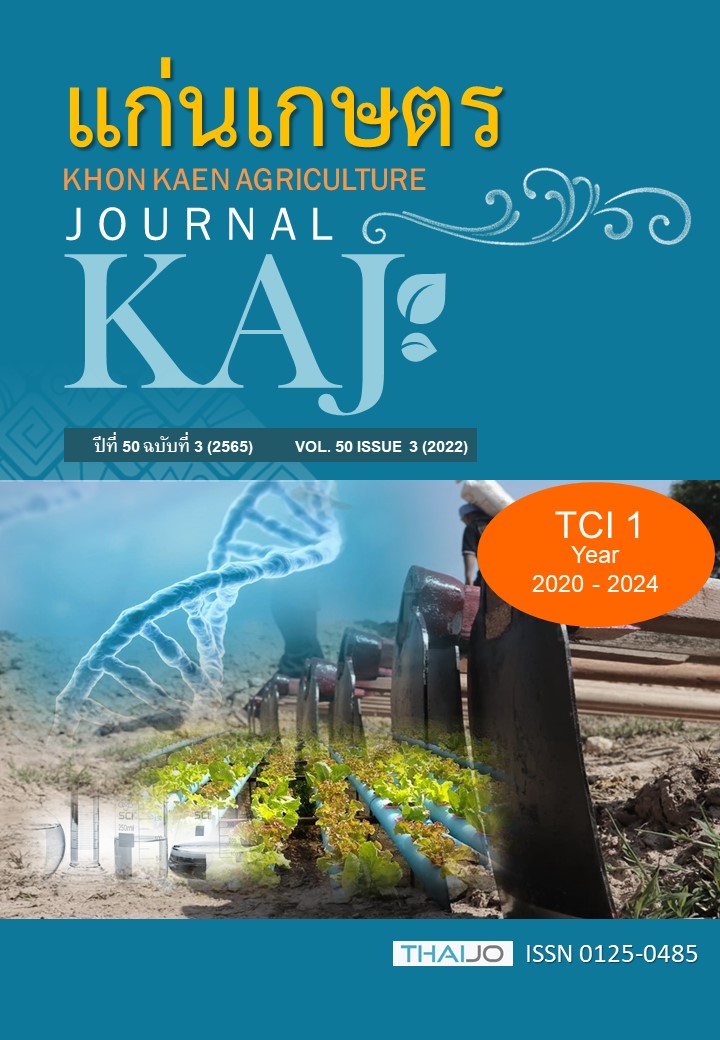วิธีการประเมินเชื้อพันธุกรรมอ้อยต้านทานต่อเพลี้ยจักจั่นปีกลายจุดสีน้ำตาล Matsumuratettix hiroglyphicus (Matsumura) พาหะนำโรคใบขาวอ้อย
Main Article Content
บทคัดย่อ
โรคใบขาวอ้อยทำความเสียหายอย่างมากต่ออุตสาหกรรมอ้อยในประเทศไทย มีเพลี้ยจักจั่นปีกลายจุดสีน้ำตาล Matsumuratettix hiroglyphicus (Matsumura) เป็นแมลงพาหะที่สำคัญนำเชื้อไฟโตพลาสมา ปัจจุบันยังไม่มีพันธุ์อ้อยที่ต้านทานต่อโรคใบขาวอ้อย การศึกษานี้เพื่อพัฒนาวิธีการประเมินพันธุ์อ้อยต้านทานต่อแมลงพาหะจากการเจาะดูดกินน้ำเลี้ยงพืชของแมลงโดยใช้รอยเจาะของปลอกหุ้มน้ำลายและการปล่อยมูลหวาน ผลต่อการเจริญเติบโตและการรอดชีวิตของแมลงพาหะ ผลการศึกษาได้จัดแบ่งระดับความต้านทานอ้อยที่ทดสอบ 7 เชื้อพันธุกรรม จาก 2 สกุล คือ Erianthus และ Saccharum ได้ 3 กลุ่ม 1) พันธุ์ต้านทานต่อแมลงพาหะ ในอ้อยสกุล Erianthus ได้แก่ เชื้อพันธุกรรม ThE10-6, ThE99-146, ThE99-91, ThE03-7 และ ThE03-5 พบจำนวนเฉลี่ยของรอยเจาะปลอกหุ้มน้ำลายมาก 20.50 ± 4.55 ถึง 23.50 ± 3.53 รอยเจาะ มีพื้นที่มูลหวานที่แมลงขับออกมา 0.13 ± 0.29 ถึง 0.78 ± 0.96 ตารางมิลลิเมตร แมลงพาหะไม่สามารถเจริญเติบโตได้ และไม่สามารถถ่ายทอดเชื้อไฟโตพลาสมาสู่อ้อยได้ 2) พันธุ์ต้านทานปานกลางต่อแมลงพาหะ อ้อยสกุล Saccharum เชื้อพันธุกรรม UT5 และ 3) พันธุ์ไม่ต้านทานต่อแมลงพาหะ อ้อยสกุล Saccharum เชื้อพันธุกรรม KK3 มีจำนวนเฉลี่ยรอยเจาะปลอกหุ้มน้ำลายน้อยที่สุด 13.35 ± 4.56 รอยเจาะ มีพื้นที่มูลหวาน 15.13 ± 5.91 ตารางมิลลิเมตร แมลงสามารถดูดกินอ้อยได้ดีทำให้เจริญเติบโตจนครบวงจรชีวิต มีระยะเวลาการพัฒนาจากระยะไข่จนถึงตัวเต็มวัย 62.69 ± 3.07 วัน อัตราการรอดชีวิต 83.33 % ดังนั้นการใช้วิธีการประเมินผลของความต้านทานของพันธุ์อ้อยต่อการดูดกินและการเจริญเติบโตของแมลงพาหะ สามารถใช้ในการคัดเลือกพันธุ์อ้อยที่ต้านทานต่อแมลงพาหะนำโรคใบขาวอ้อยได้
Article Details

อนุญาตภายใต้เงื่อนไข Creative Commons Attribution-NonCommercial-NoDerivatives 4.0 International License.
เอกสารอ้างอิง
ประสิทธิ์ ใจศิล และ สมพิศ แย้มมั่นคง. 2558. พันธุอ้อยในประเทศไทย. สำนักงานคณะกรรมการอ้อยและน้ำตาลทราย กระทรวงอุตสาหกรรม และมหาวิทยาลัยขอนแก่น.
วีระพล พลรักดี, ทักษิณา ศันสยะวิชัย, เพียงเพ็ญ ศรวัต, เทวา เมาลานนท์, ปรีชา กาเพ็ชร และอุดม เลียบวัน. 2554. ขอนแก่น 3 พันธุ์อ้อยสำหรับภาคตะวันออกเฉียงเหนือ. วารสารวิชาการเกษตร. 29: 283-301.
Amalraj, V.A., P. Rakkiyappan, D. Neelamathi, S. Chinnaraj, and S. Subramanian. 2008. Wild cane as a renewable source for fuel and fiber in the paper industry. Current Science. 95: 1599-1602.
Ammar, E.D., R. Alessandro, R.G. Shatters, and D.G. Hall. 2013. Behavioral, ultrastructural and chemical studies on the honeydew and waxy secretions by nymphs and adults of the Asian citrus psyllid Diaphorina citri (Hemiptera: Psyllidae). PLoS ONE. 8: 1-10.
Chanchala, K.M.G., V.K.A.S.M. Wanasinghe, K.S. Hemachandra, L. Nugaliyadde, and W.R.G. Witharama. 2020. Effect of the epicuticular wax level of leaf lamina on the behaviour of leaf hopper Deltocephalus menoni (Hemiptera: Cicadellidae); A vector of sugarcane white leaf disease. Tropical Agricultural Research. 31: 73-85.
Chen, C.T. 1974. Sugarcane white leaf disease in Thailand and Taiwan. Sugarcane pathologist’s newsletter. 11: 12-23.
Fortes, I.M., R. Fernández-Muñoz, and E. Moriones. 2020. Host plant resistance to Bemisia tabaci to control damage caused in tomato plants by the emerging crinivirus tomato chlorosis virus. Frontiers Plant Science. 14: 1-9.
Goggin, F.L., A. Lorence, and C.N. Topp. 2015. Applying high-throughput phenotyping to plant–insect interactions: picturing more resistant crops. Current Opinion in Insect Science. 9: 69–76.
Hanboonsong Y., C. Choosai, S. Panyim, and S. Damak. 2002. Blackwell science Ltd transovarial transmission of sugarcane white leaf phytoplasma in the insect vector Matsumuratettix hiroglyphicus (Matsumura). Insect Molecular Biology. 11: 97-103.
Hanboonsong, Y., W. Ritthison, C. Choosai, and P. Sirithorn. 2006. Transmission of Sugarcane white leaf phytoplasma by Yamatotettix flavovittatus, a new leafhopper vector. Journal of Economic Entomology. 99: 1531-1537.
Hanley, M.E., B.B. Lamont, M.M. Fairbanks, and C.M. Rafferty. 2007. Plant structural traits and their role in anti-herbivore defense. Perspectives in Plant Ecology, Evolution and Systematics. 8: 157–178.
Kawabe, S. 1985. Mechanism of varietal resistance to the rice green leafhopper (Nephotettix cincticeps Uhler). Japan Agricultural Research Quarterly. 19: 115-124.
Kobori, Y., and Y. Hanboonsong. 2017. Effect of temperature on the development and reproduction of the sugarcane white leaf insect vector, Matsumuratettix hiroglyphicus (Matsumura) (Hemiptera: Cicadellidae). Journal of Asia-Pacific Entomology. 20: 281–284.
Kumarasinghe, N.C., N. Salim, and W. Wijayarathne. 2010. Identification and biology of two whitefly species on cassava in sri lanka. Journal of plant protection research. 49: 373-377.
Pathak, P.K., R.C. Saxena, and E.A. Heinrichs. 1982. Parafilm sachet for measuring honeydew excretion by Nilaparvata lugens on rice. Journal of Economic Entomology. 75: 194-195.
Ram, B., T.V. Sreenivasan, B.K. Sahi, and N. Singh. 2001. Introgression of low temperature tolerance and red rot resistance from Erianthus in sugarcane. Euphytica. 122: 145–153.
Rezaul Karim, A.N.M., and R.C. Saxena. 1991. Feeding behavior of three Naphotettix species (Homoptera: Cicadellidae) on selected resistant and susceptible rice cultivars, wild rice, and graminaceaous weeds. Journal of Economic Entomology. 84: 1208-1215.
Roddee, J., Y. Kobori, H. Yorozuya, and Y. Hanboonsong. 2017. Characterization of direct current-electrical penetration graph waveforms and correlation with the probing behavior of Matsumuratettix hiroglyphicus (Hemiptera: Cicadellidae), the insect vector of sugarcane white leaf phytoplasma. Journal of Economic Entomology. 110: 893–902.
Saxena, R.C. 1987. Antifeedants in tropical pest management. Insect Science and Its Application. 8: 731–736.
Schlick-Souza, E.C., E.L.L. Baldin, R. Morando, and A.L. Lourenção. 2018. Antixenosis to chrysodeixis includens (Lepidoptera: Noctuidae) among soybean genotypes. Bragantia. 77: 1–10.
Sedano, M., N. Lam, I. Escobar, T. Cross, S.F. Hanson, and R. Creamer. 2012. Application of vascular puncture for evaluation of curtovirus resistance in chile pepper and tomato. Journal of Phytopathology. 160: 120–128.
Seo, B.Y., J.K. Jung, B.R. Choi, H.M. Park, S.W. Lee, and B.H. Lee. 2010. Survival rate and stylet penetration behavior of current Korean populations of the brown planthopper, Nilaparvata lugens, on resistant rice varieties. Journal of Asia-Pacific Entomology. 13: 1–7.
Sogawa, K., and M.D. Pathak. 1970. Mechanisms of brown planthopper resistance in mudgo variety of rice (Hemiptera: Delphacidae). Applied Entomology and Zoology. 5: 145-158.
Tagane, S., W. Ponragdee, T. Sansayawichai, A. Sugimoto, and Y. Terajima. 2011. Characterization and taxonomical note about Thai Erianthus germplasm collection: the morphology, flowering phenology and biogeography among E. procerus and three types of E. arundinaceus. Genetic Resources and Crop Evolution. 59: 769–781.
War, A.R., H.C. Sharma, M.G. Paulraj, M.Y. War, and S. Ignacimuthu. 2011. Herbivore induced plant volatiles: their role in plant defense for pest management. Plant Signaling and Behavior. 6: 1973–1978.
Wongkaew, P., Y. Hanboonsong, P. Sirithorn, C. Choosai, S. Boonkrong, T. Tinnangwattana, R. Kitchareonpanya, and S. Damak. 1997. Differentiation of phytoplasmas associated with sugarcane and gramineous weed white leaf disease and sugarcane grassy shoot disease by RFLP and sequencing. Theoretical Applied Genetics. 95: 660-663.
Yorozuya, H. 2017. Analysis of tea plant resistance to tea green leafhopper, Empoasca onukii, by detecting stylet-probing behavior with DC electropenetrography. Entomologia Experimentalis et Applicata. 165: 62–9.
Yorozuya, H., and J. Tanaka. 2012. The degrees of feeding damage and the numbers of probing punctures by tea green leafhopper, Empoasca onukii Matsuda in tea germplasms. Kyusyu Plant Protection Research. 58: 93–99.


